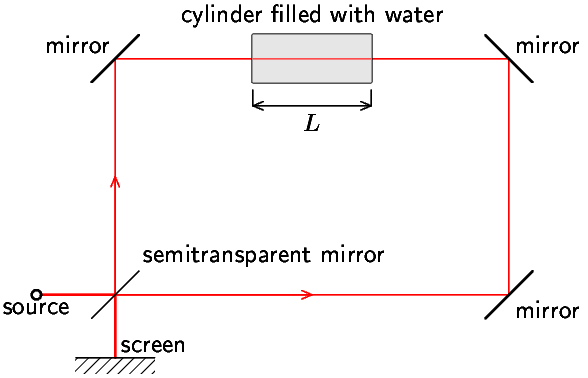Search
astrophysics (85)biophysics (18)chemistry (23)electric field (71)electric current (75)gravitational field (81)hydromechanics (146)nuclear physics (44)oscillations (57)quantum physics (31)magnetic field (43)mathematics (89)mechanics of a point mass (298)gas mechanics (87)mechanics of rigid bodies (221)molecular physics (71)geometrical optics (78)wave optics (65)other (167)relativistic physics (37)statistical physics (21)thermodynamics (154)wave mechanics (51)
wave optics
1. Series 23. Year - S. Petrin mirror maze
- What will you see when standing between two vertical mirrors connected at right angle?
- Lets have plane mirror inclined at angle 45°, moving to the left at the speed $v$. From the right there is a light ray of speed $c$ (e.g. angle of incidence is 45°) and is reflected upwards. Using Huygens principle calculate angle between incoming and reflected ray, e.g. correct the law of reflection for mowing mirrors.
Z dílny Dalimilovy.
3. Series 22. Year - S. ccccceeeee

* Imagine a strong laser at wavelength 400 nm, and shine it at the Moon. On its surface the light will reflect and come back. Assuming circular orifice of diameter of 1 cm through which the beam is going, what will be the diameter of the reflection on the Earth? Hint: It will be much more, than 1 cm.
- In this task assume, that the aether really exists and predict, what will happen, if Mr. Michelson would make its measurement by other means: one arm would be 5 meters long and other 10 meters long. Such apparatus would create some interference pattern. Then he would rotate whole experiment by 90$°$, so both arms changed its positions. During rotating the experiment, we would see changes in interference patterns (assume rotating doubleslit). How would the interference patterns move at above rotation? How long would have to be the longer arm to inverse the interference fringes (e.g. minima would become maxima)?
- In the following task again assume existence of aether and that a body moving in aether is pulling it completely with to body, so the relative speed of aether to the body is zero. What would be then phase shift between two beams in the system in above figure? The light is splitted at semitransparent mirror into two beams and continues at perfectly rectangular path back to the semitransparent mirror, where it reaches screen at which interference fringes are observed. On the way are both beams three times reflected by a mirror and are going through the cylinder of length $L$, filled with water. Whole system is moving relatively to aether at speed $v$ to the right (do not forgot, that the cylinder is not moving relatively to aether!).
Zadali autři seriálu.
1. Series 20. Year - 4. captains diary
Contribute by some interesting record to the diary of the expedition (image, artistic creature, adventure story of length of daily observation, physical observation, …).
Napadlo Honzu Prachaře.
3. Series 15. Year - 4. accuracy of GPS
The Global Positioning System (GPS) is based on a rather simple principle. Satellites on 12-hour orbits emit perfectly synchronized signals then detected by a receiver. The receiver cannot carry perfect clock and therefore can detect only differences of distances to the satellites (i.e. it cannot measure the distance, but only the difference between two distances). Four satellites are enough to calculate the position.
Explain, why is the accuracy of GPS significantly better in the horizontal direction than in the vertical direction.
Při hledání informací o GPS zaujalo Honzu Houšťka.
3. Series 15. Year - E. reflexivity
Measure the coefficient of reflexivity of aluminium foil in the visible light. Suggest an appropriate method. Do not forget to describe the side of the foil you measure.
Zadal Honza Houštěk.
3. Series 15. Year - S. rychlejší než světlo?
In this problem we analyse and interpret measurements made in 1994 on radio wave emition from a source consisting multiple bodies within our galaxy. The distance to the central celestial body from Earth is estimated to be $R = 3,86.10^{20}$ m. The angular velocities of two objects ejected from the centre in opposite directions were measuredyo be: $\omega _{1} = 9,73.10^{-13} rad.s^{-1}$ and $\omega _{2} = 4,42.10^{-13} rad.s^{-1}$. We calculate the transverse velocities: $v_{1} = R\omega _{1} =3,76.10^{8} m.s^{-1}$ and $v_{2} = R\omega _{2} = 1,71.10^{8} m.s^{-1}$. The first object is faster than light! How is it possible?
Let's consider an object moving with velocity $v$. The angle between the velocity vector and the direction to the observer is $\varphi$. The distance to the observer is denoted $R$. Calculate the angular velocity as seen by the observer. Can $Rω$ be greater than the speed of light? Using your results calculate the real velocities of the two objects. Assume that the velocities are equal.
Zadal autor seriálu Karel Kolář.